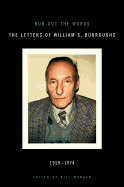
Rub Out the Words, published 18 years after the first volume of William S. Burrough's correspondence, picks up right where its predecessor left off--the very next day, in fact. It's 1959, a few months after the European publication of Naked Lunch, and though Burroughs is still in touch with Allen Ginsberg, he's also beginning to forge relationships, as editor Bill Morgan (who also edited the correspondence of Ginsberg, Kerouac and others) explains, with "a new coterie of creative people who were not related to the Beat Generation." Chief among these was Brion Gysin, a writer and artist who introduced Burroughs to the "cut-up" technique of breaking down written works into new sequences, which increasingly shaped his writing.
Morgan (The Typewriter Is Holy) maintains a minimal presence. Before the letters begin, he offers a timeline laying out key events in Burroughs's life during this 15-year period; after that, he limits himself to footnotes identifying people and art works and an occasional elaboration of context. Certain themes emerge: Burroughs was a vocal advocate of using apomorphine as a treatment for drug addiction. He also fought persistently against his reputation as a drug addict.
Rub Out the Words offers us intimate glimpses of Burroughs's personality. It isn't always pleasant, but when he expresses frustration over his son's drug addiction or marvels at the explosion of gay porn being freely shown in Times Square by the early 1970s, readers are reminded of the real life obscured by Burroughs's literary iconography. This collection offers insight into Burroughs's life and art not available anywhere else. --Ron Hogan, founder of Beatrice.com

